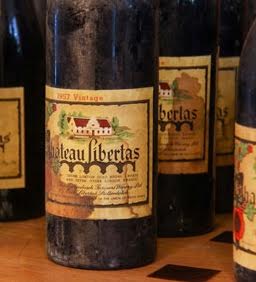Tim James: Could great old names be rescued?
By Christian Eedes, 3 August 2015

1
 An almost inevitable topic came up for discussion among those attending the recent grand match between some old Cape stars and their international equivalents: the modern decline in reputation of wines like Chateau Libertas – the 1959 vintage of which had just given us all great satisfaction. I’ve had, incidentally, many fine old vintages of this wine, going back to a fragile but still lovely 1940. The modern version is not a bad wine, but it’s not even to be mentioned in the same breath as the old ones.
An almost inevitable topic came up for discussion among those attending the recent grand match between some old Cape stars and their international equivalents: the modern decline in reputation of wines like Chateau Libertas – the 1959 vintage of which had just given us all great satisfaction. I’ve had, incidentally, many fine old vintages of this wine, going back to a fragile but still lovely 1940. The modern version is not a bad wine, but it’s not even to be mentioned in the same breath as the old ones.
The same could be said most obviously for Zonnebloem: before the 1960s this was an estate which produced some cabernets that have astounded international and then local wine lovers. After the name was appropriated (in rather dubious circumstances) by Stellenbosch Farmers’ Winery, a component of the later Distell, it became the name of a brand – one which was to soon start declining towards the rather humdrum level it occupies today.
Alto is another obvious candidate for the sad distinction of belonging to this category of grand old names in calculated decline. Alto is, of course, an estate rather than a mere brand, belonging to Lusan Premium Wines, the joint venture between Distell and German financier Hans Schreiber. In fact, the Lusan properties are a bunch of estates that turned their back on high ambition in favour of high yields, lesser quality and bigger profits. (Just think of Le Bonheur, for example, another somewhat ordinary producer now, and remember that its cabernet was one of the relatively few first-class wines of the 1980s, before owner-winemaker Mike Woodhead lost the farm in the early 1990s.)
I said “calculated decline”, because what happened with Chateau Lib et al was not the natural decadence that sometimes happens in family properties; this was a choice. In wine, as in so many other things, it can be wise, if you want to make a lot of money, to go downmarket. Anyway it’s what big wine business, headed by the KWV overlords, decided to do in the years when apartheid and resultant sanctions helped make the local wine scene a pretty dreary one. Who wouldn’t rather have a Chateau Libertas or a Zonnebloem from the 1960s or 70s rather than anything later? But if big profit is what you’re after, it’s preferable to have busloads of tourists pouring into Stellenzicht and Neethlingshof (other Lusan properties) rather than be an ambitious, wine-passionate little outfit desperately working to raise quality.
This was largely taken for granted the other night, when we broached the topic. But the question was wistfully raised: couldn’t these great old brands be revived, to do them honour? I suppose it wouldn’t be out of the question with some of the estates, like Alto and Le Bonheur, but it would be more difficult – and involve an expensive rebranding exercise – with Chateau Libertas and Zonnebloem. More to the point, Distell shows no sign of wanting to do so – any real ambitions for quality seem channelled mostly into Nederburg (another label with some splendid old wines). Especially with Zonnebloem, the nobler past is exploited in marketing to add a spurious credibility to the current dull efforts, but there seems no intention of basically refounding the brand.
I was told recently, when I wrote cheerfully on Grape about the handing down of some fine producers to the second generation, that the son of Alto winemaker Schalk van der Westhuizen, Bertho, has taken over there as cellarmaster. This dynastic impulse could be an unusually interesting move by Distell/Lusan – it seems to suggest some interest in the property beyond a wish to merely replace one competent winemaker with another to follow orders to make, essentially, more of the same. Perhaps. Let’s hope so. Good luck, Bertho. It would be great to have this wasted, but historic and potentially fine estate on the slopes of the Helderberg striving once again to make great wine. But I’m not going to hold my breath.
- Tim James is founder of Grape.co.za and contributes to various local and international wine publications. He is a taster (and associate editor) for Platter’s. His book Wines of South Africa – Tradition and Revolution appeared in 2013.







Jonathan Snashall | 3 August 2015
Yep esp when this type of tradition / history can be so helpful in trying to lift (desperately needed) retail price points, while they could create new brands /sub brands for their cash cows. Also, aren’t we now passed tip toeing around the bad old days?